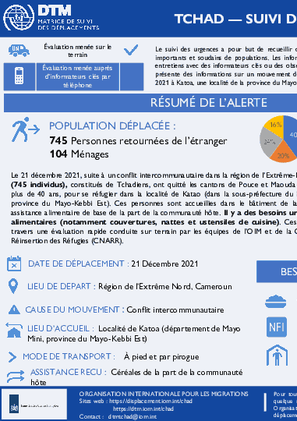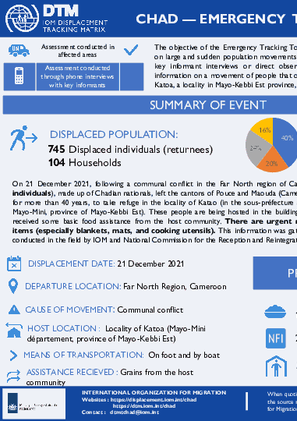-
Countries
-
Data and Analysis
-
Special Focus
-
Crisis Responses

Contact
DTM Niger, DTMNiger@iom.int
Language
French
Location
Niger
Period Covered
Dec 01 2021
Dec 31 2021
Activity
- Flow Monitoring
Afin de mieux comprendre les mouvements et tendances migratoires en Afrique de l’Ouest et du Centre, l’OIM, à travers la Matrice de suivi des déplacements (Displacement Tracking Matrix, DTM), met en œuvre l’activité de Suivi des flux de populations (Flow Monitoring, FM). Au Niger, la DTM recueille des données à 7 Points de suivi des flux (Flow Monitoring Point, FMP), dans le but d’identifier les zones à forte mobilité transfrontalière et intra régionale et récolter des données sur les tendances de mobilités et les profils et parcours des voyageurs dans le pays. Ce rapport présente les données obtenues au travers des activités d’enregistrement des flux en Décembre 2021, au niveau des sept FMP installés au Niger.

Contact
DTM Tchad, dtmtchad@iom.int
Language
French
Location
Chad
Snapshot Date
Jan 21 2022
Activity
- Event Tracking
- Mobility Tracking
Le 21 décembre 2021, suite à un conflit intercommunautaire dans la région de l’Extrême-Nord au Cameroun, 104 ménages (745 individus), constitués de Tchadiens, ont quitté les cantons de Pouce et Maouda (Cameroun), où ils vivaient depuis plus de 40 ans, pour se réfugier dans la localité de Katao (dans la sous-préfecture du Katao, département du Mayo-Mini, province du Mayo-Kebbi Est). Ces personnes sont accueillies dans le bâtiment de la sous-préfecture et ont reçu une assistance alimentaire de base de la part de la communauté hôte. Il y a des besoins urgents en vivres et articles non alimentaires (notamment couvertures, nattes et ustensiles de cuisine). Ces informations ont été collectées à travers une évaluation rapide conduite sur terrain par les équipes de l’OIM et de la Commission Nationale d'accueil de Réinsertion des Réfugies (CNARR).

Contact
DTM Chad, dtmtchad@iom.int
Language
English
Location
Chad
Snapshot Date
Jan 21 2022
Activity
- Event Tracking
- Mobility Tracking
On 21 December 2021, following a communal conflict in the Far North region of Cameroon, 104 households (745 individuals), made up of Chadian nationals, left the cantons of Pouce and Maouda (Cameroon), where they had been living for more than 40 years, to take refuge in the locality of Katao (in the sous-préfecture also called Katao, département of Mayo-Mini, province of Mayo-Kebbi Est). These people are being hosted in the building of the sous-préfecture and have received some basic food assistance from the host community. There are urgent needs for food and non-food items (especially blankets, mats, and cooking utensils). This information was gathered through a rapid assessment conducted in the field by IOM and National Commission for the Reception and Reintegration of Refugees (CNARR) teams.

Contact
DTM Ethiopia, SLOAddisAbabaDTM@iom.int
Language
English
Location
Ethiopia
Period Covered
Dec 01 2021
Dec 31 2021
Activity
- Flow Monitoring
In December 2021, a total of 18,049 movements were observed across five of Ethiopia's flow monitoring points (FMPs). It should be noted that data collection at Humera FMP in Tigray region did not take place due to security and access constraints, thus affecting the total number of movements for the month. This represents a 5.1% increase in daily average movements in comparison with November 2021 when an average of 554 movements per day were observed.
Outgoing movements during December have continued to be higher than ever (87.2%) than incoming movements (12.8%). A total of 15,743 outgoing movements were observed of which 6,250 (39.7%) were heading towards Saudi Arabia, 2,903 (18.4%) were going to Kenya, 2,422 (15.4%) were travelling towards Djibouti, 943 (6.0%) to South Africa, 630 (4.0%) intended to reach Somalia and 606 (3.8%) headed to the United Arab Emirates.
At the same time, 2,306 incoming movements were observed, of which 780 (33.8%) had originated from Djibouti, while 615 (26.7%) came from Kenya, 397 (17.2%) from Somalia, 297 (12.9%) movements from Sudan, 216 from Yemen (9.4%) and the remaining migrant travelled from Uganda. Almost all of these were Ethiopian nationals who were likely returning home.
Contact
dtmlibya@iom.int
Location
Libya
Activity
- Mobility Tracking
- Baseline Assessment
Period Covered
Oct 01 2021 -Nov 30 2021
IDP and Returnees Round 39 Dataset.
Population Groups
Survey Methodology
Unit of Analysis Or Observation
Type of Survey or Assessment
Keywords
Geographical Scope
Administrative boundaries with available data
The current dataset covers the following administrative boundaries

Contact
DTM Libya, DTMLibyateam@iom.int
Language
English
Location
Libya
Period Covered
Oct 01 2021
Nov 30 2021
Activity
- Mobility Tracking
- Baseline Assessment
This infographic presents the key findings of Round 39 of the mobility tracking component of the Displacement Tracking Matrix (DTM) programme in Libya.

Contact
DTM Libya, DTMLibya@iom.int
Language
English
Location
Libya
Period Covered
Oct 01 2021
Nov 30 2021
Activity
- Mobility Tracking
- Baseline Assessment
This report presents the data on internally displaced persons (IDPs) and returnees between October – November 2021. The data and findings represent round 39 of the Displacement Tracking Matrix’s (DTM) Mobility Tracking. In Libya, no new mass displacements have been reported since June 2020, and throughout 2021 IDPs have continued to return to their communities of origin. Consistent with the annual trend, in this round of reporting, the numbers of IDPs within the country continued decreasing, with a parallel increase in the number of returnees.
As compared to an estimated 648, 317 returnees reported in round 38, the number of those identified during round 39 increased to 661,892 individuals. This indicates a slight increase in the percentage of those returning (2%), after a period of plateauing across the past 6 months.

Contact
DTM Mauritania, DTMMauritania@iom.int
Language
French
Location
Mauritania
Period Covered
Nov 01 2021
Nov 30 2021
Activity
- Survey
- Flow Monitoring Survey
- Flow Monitoring
La transhumance est une pratique de longue date en Mauritanie où elle a évolué au cours des dernières décennies telles que la raréfaction des ressources impliquant la redéfinition des routes empruntées par les troupeaux. Par conséquent, des conflits peuvent survenir lorsque les agriculteurs et les éleveurs transhumants. Dans le cadre du Suivi des Mouvements de Transhumance, l’OIM met en œuvre un système d’alerte qui a pour objectif de recenser les mouvements inattendus de bétail et les conflits ou catastrophes naturelles liés à l’utilisation des ressources naturelles et aux interactions entre agriculteurs et éleveurs, de comprendre les modes de résolution de conflits existants et d’informer les autorités compétentes, dans l’objectif de réduire les tensions dans les régions d’intervention. Ce tableau de bord présente les informations fournies par le biais de 21 informateurs clés, présents dans huit régions (Assaba, Brakna, Gorgol, Guidimakha, Hodh El Chargui, Hodh El Gharbi, Tagant et Trarza) pendant le mois de novembre 2021.

Contact
DTM Mali, DTMMali@iom.int
Language
English
Location
Mali
Period Covered
Dec 01 2021
Dec 31 2021
Activity
- Survey
- Flow Monitoring Survey
- Flow Monitoring
In order to gain a better understanding of mobility flows and trends, the International Organization for Migration (IOM) has implemented the Displacement Tracking Matrix’s Flow Monitoring (FM) tool at key transit points across the region. Flow Monitoring activities are conducted in close cooperation with national and local authorities as well as local partners. The Flow Monitoring tool consists of two main components: the Flow Monitoring Registry (FMR), which captures key data on the volume, origin, destination and mode of travel of mobility flows, and the Flow Monitoring Survey (FMS), individual surveys conducted with travellers to gather detailed information about the profiles, migration experience and intentions of migrants. Through these activities, the Flow Monitoring tool collects data on migration flows and trends, traveller profiles, migration journeys, and intentions of migrants, so as to obtain a better understanding of mobility.
In Mali, DTM conducts Flow Monitoring activities at seven Flow Monitoring Points (FMPs) located across six regions, in order to foster a better understanding of the numbers, trends, profiles, and journeys of migration flows crossing these points.
This reports presents data collected through the Flow Monitoring Registry in December 2021.

Contact
DTM Mali, DTMMali@iom.int
Language
French
Location
Mali
Period Covered
Dec 01 2021
Dec 31 2021
Activity
- Flow Monitoring Survey
- Flow Monitoring
Afin de mieux comprendre les mouvements et tendances migratoires, l’OIM, à travers la Matrice de suivi des déplacements (Displacement Tracking Matrix, DTM), met en œuvre l’activité de Suivi des flux de populations (Flow Monitoring, FM).
Le suivi des flux, qui est mis en œuvre en étroite collaboration avec les autorités et des partenaires nationaux et locaux, est composé de deux outils: l’enregistrement des flux (Flow Monitoring Registry, FMR), qui recueille des données clés sur l’ampleur, la provenance, la destination et les modalités des flux de mobilité, et les enquêtes individuelles (Flow Monitoring Survey, FMS), conduites auprès des voyageurs afin d’obtenir des informations sur les profils, parcours migratoires, et intentions des migrants. Le suivi des flux de populations récolte ainsi des données sur les flux et tendances migratoires, les profils des voyageurs et les parcours et intentions des migrants, afin de fournir une meilleure compréhension des mobilités.
Au Mali, la DTM recueille des données au niveau de 7 Points de suivi des flux (Flow Monitoring Points, FMP), répartis dans 6 régions afin d’obtenir une meilleure compréhension de l’ampleur, des tendances, des caractéristiques socio-démographiques et des parcours des flux de voyageurs traversant ces différents points.
Ce rapport présente les données recueillies dans le cadre des activités d’enregistrement des flux durant le mois de décembre 2021.